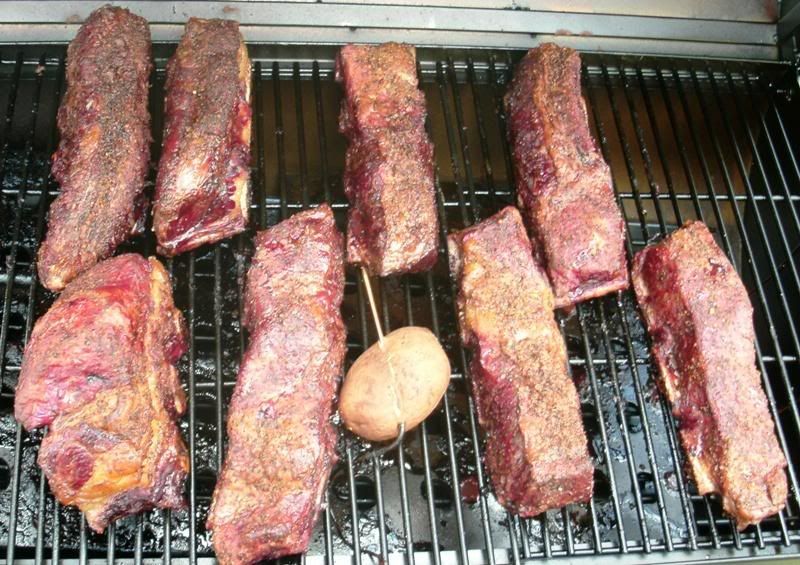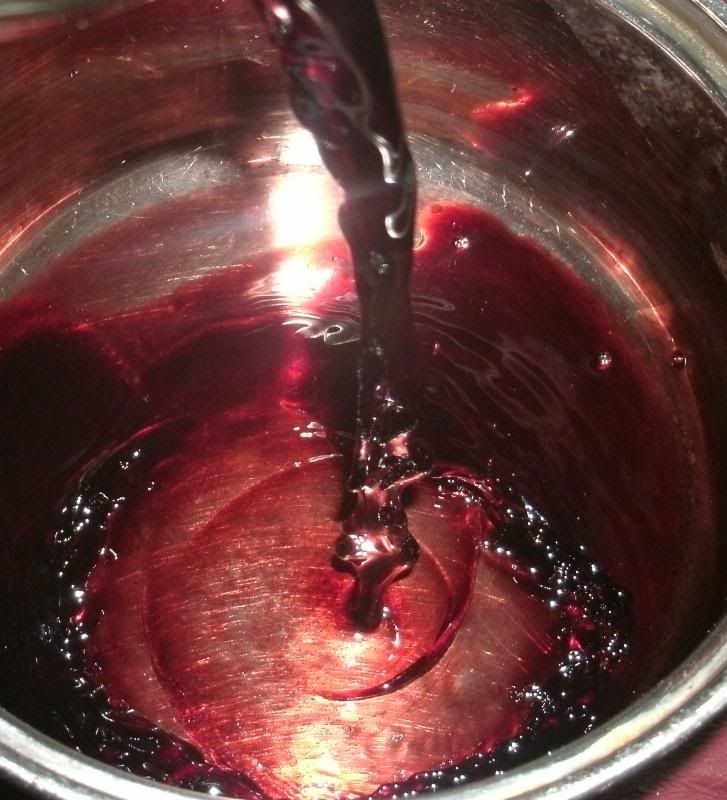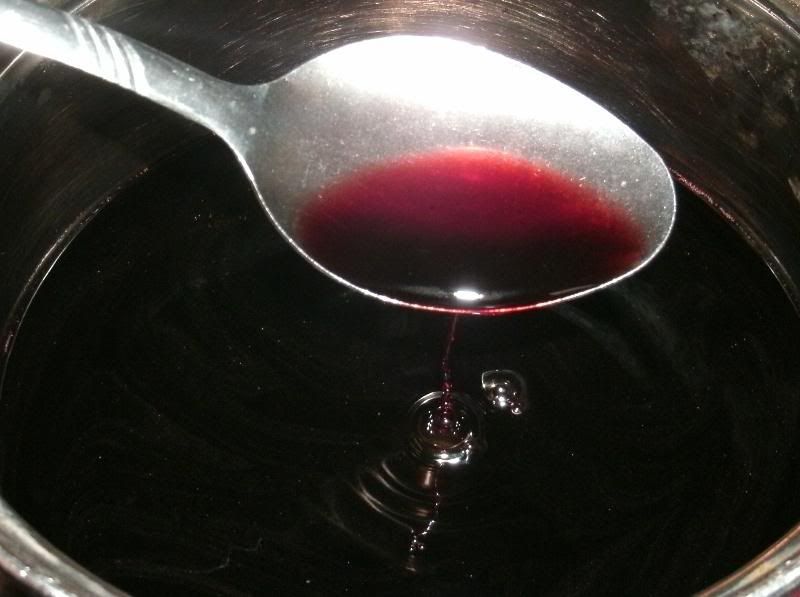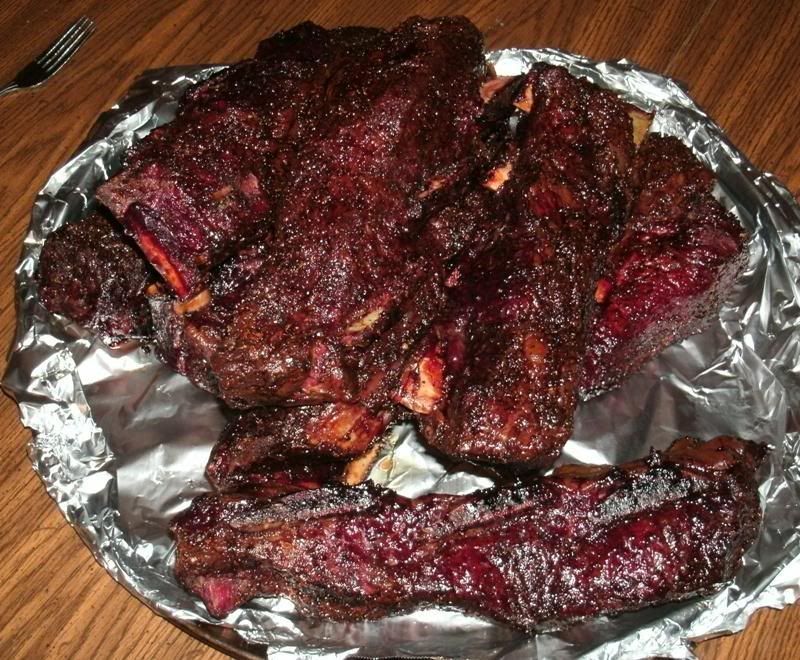Post by TasunkaWitko on Aug 13, 2012 13:02:17 GMT -5
Home-Grown Beef Short Rib Kalimotxo Barbecue
Ever since my good friend Dave introduced me to the idea of kalimotxo with his outstanding post:
foodsoftheworld.activeboards.net/kalimotxo-short-ribs_topic1462.html
I've been in love with the concept. This simple, yet oh, so good Basque combination of red wine and cola is a beautiful thing. It's a common beverage in Basque country, and has gained popularity in similar forms around the world; however, it seems particularly suited for beef, as I discovered when I created my own kalimotxo dish:
foodsoftheworld.activeboards.net/carne-de-res-kalimotxo_topic1582.html
Anyway, you can read more about this history, distribution and background of kalimotxo by reading the posts above - my goal today isn't to educate you on kalimotxo, but rather to show you yet another wonderful use for it!
About a month ago, I was able to re-visit this wonderful concoction when I barbecued beef short ribs from our own family beef in celebration of my oldest son's 22nd birthday. As is often the case, the overall theme of the barbecue was a result of a discussion on FotW; several of us had been discussing the merits of a mustard slather for barbecue:
foodsoftheworld.activeboards.net/mustard-slather-for-barbecue_topic350.html
And the question came up as to whether Dijon mustard could be used as the slather. Common sense says that yes it can, but for some reason, a few years ago when I tried it, the results didn't seem very good on barbecue; it works very well with meat cooked in the oven, but for some reason my impression was that it didn't take too well with meat cooked over a fire - and this was something of a mystery that seemed to grow, the more we discussed it. There was no real reason for it to taste bad, and the recent mustard slather discussion got me to thinking that my negative experience was just a fluke - so, what else could I do but test the theory?
My plan was to lay down some Dijon mustard and apply a very simple rub that is guaranteed to compliment beef: a simple combination of sea salt, freshly-cracked black pepper, granulated garlic and onion, and a very modest amount of dried red pepper. I've heard this described as a "Kansas City" seasoning, and also a "Montreal" seasoning. I don't know if it is either or both, and my focus at this time was on Dijon rather than Montreal or Kansas City, so it really didn't matter - I simply knew it would taste good with beef, no matter what!
Anyway, the rest of my plan was simple: barbecue the ribs over hickory until they were tender, juicy and full of smoky goodness, and then apply a wonderful, rich sweet-tart kalimotxo reduction as a glaze. This "experiment" would accomplish several things: 1) it would settle the question (in my mind, at least), about whether Dijon mustard makes a good slather for barbecue; It would also 2) provide a platform for a new way to enjoy kalimotxo. Finally, it would 3) provide a wonderful and unique barbecue for my son's birthday!
The beef ribs that we used for this were wonderful, large meaty hunks of Montana goodness, taken from our own family beef and reserved especially for an occasion such as this. I was eager to get going with the project, and even though I was a little anxious about whether or not the Dijon would work, I was nevertheless expecting some really good things.
I could have sworn I had a picture of the beef ribs out of the butcher paper; also laid out with the mustard slather and then the rub; however, a diligent search of my camera and my computer turned up nothing, so the pictures were either lost, or they never existed to begin with. When you have 4 children, things tend to get fuzzy after your 40th birthday, especially when you're half-North-Dakotan and have a lot of things going on. Anyway, we begin our saga toward the end of the barbecue process, where things really started to happen anyway.
Here we are, shorties looking wonderful after bathing in hickory over a low-n-slow for several hours:

I can never seem to get good pictures off my barbecue pit - they're always just slightly fuzzy, or washed out in the sunlight, or there's a heavy shadow from the lid of the pit - or something; but as you can see, the colours really come through here. I could have served these shorties just as they were, and I am confident they would have received rave reviews, but we still had a ways to go.
I had started a 20-ounce bottle of Coca-Cola reducing with an equal amount of red wine (as I recall, it was a Cabernet Sauvignon from Oak Leaf vineyards, but I cannot swear to it) in a large pot. When the reduction got down to something more manageable, I transferred it to a small saucepan:

And began my final reduction until the kalimotxo was deep, rich and nearly syrupy:

From there, I "painted" it on the beef ribs during their last hour, maybe hour-and-a-half on the pit, going in several thin layers so as not to let anything get to gloppy. Also, thicker layers tend to carbonise easier, losing their wonderful depth and sheen, and turning into a mess. Aesthetically, I think I did pretty well, judging by these results:

Looking at another angle, the deep, dark mahogany sheen resulting from the combination of the smoke and the kalimotxo glaze really takes on an importance:

The picture above on the grates shows some really nice ribs, indeed; however, after receiving their lacado kalimotxo (kalimotxo lacquer), they really take on a special quality.
The beef ribs turned out very well in other qualities, aside from the outward appearance; as you can see here, they ended up very juicy and tender with the fat well-rendered:

The smoke ring ended up pretty nice, as well!
We served the ribs with a simple, home-made pasta salad, made from tri-coloured pasta, peas, sharp cheddar cheese and some simple seasonings, with home-made ranch dressing holding it all together:

Unfortunately, the salad got washed out in the photo, but you get the idea.
The beef ribs were large and meaty, and seemed to have the best texture and flavour potential when sliced thinly and, of course, against the grain. The tenderness was nearly melt-in-your-mouth perfect, and the Dijon slather that I had been worrying about worked with the simple dry rub in a beautiful partnership, eliminating any doubt in my mind that, for beef and with these simple flavours, Dijon is wonderful on barbecue. The Kalimotxo glaze was also a special treat, giving a tart-sweet, carmelised crackle and accent that tasted as good as it looked.
All-in-all, these two experiments, combined into one barbecue, were an unqualified success that will hopefully inspire someone to dive into the wonderful kalimotxo experience ~ enjoy!
Ever since my good friend Dave introduced me to the idea of kalimotxo with his outstanding post:
foodsoftheworld.activeboards.net/kalimotxo-short-ribs_topic1462.html
I've been in love with the concept. This simple, yet oh, so good Basque combination of red wine and cola is a beautiful thing. It's a common beverage in Basque country, and has gained popularity in similar forms around the world; however, it seems particularly suited for beef, as I discovered when I created my own kalimotxo dish:
foodsoftheworld.activeboards.net/carne-de-res-kalimotxo_topic1582.html
Anyway, you can read more about this history, distribution and background of kalimotxo by reading the posts above - my goal today isn't to educate you on kalimotxo, but rather to show you yet another wonderful use for it!
About a month ago, I was able to re-visit this wonderful concoction when I barbecued beef short ribs from our own family beef in celebration of my oldest son's 22nd birthday. As is often the case, the overall theme of the barbecue was a result of a discussion on FotW; several of us had been discussing the merits of a mustard slather for barbecue:
foodsoftheworld.activeboards.net/mustard-slather-for-barbecue_topic350.html
And the question came up as to whether Dijon mustard could be used as the slather. Common sense says that yes it can, but for some reason, a few years ago when I tried it, the results didn't seem very good on barbecue; it works very well with meat cooked in the oven, but for some reason my impression was that it didn't take too well with meat cooked over a fire - and this was something of a mystery that seemed to grow, the more we discussed it. There was no real reason for it to taste bad, and the recent mustard slather discussion got me to thinking that my negative experience was just a fluke - so, what else could I do but test the theory?
My plan was to lay down some Dijon mustard and apply a very simple rub that is guaranteed to compliment beef: a simple combination of sea salt, freshly-cracked black pepper, granulated garlic and onion, and a very modest amount of dried red pepper. I've heard this described as a "Kansas City" seasoning, and also a "Montreal" seasoning. I don't know if it is either or both, and my focus at this time was on Dijon rather than Montreal or Kansas City, so it really didn't matter - I simply knew it would taste good with beef, no matter what!
Anyway, the rest of my plan was simple: barbecue the ribs over hickory until they were tender, juicy and full of smoky goodness, and then apply a wonderful, rich sweet-tart kalimotxo reduction as a glaze. This "experiment" would accomplish several things: 1) it would settle the question (in my mind, at least), about whether Dijon mustard makes a good slather for barbecue; It would also 2) provide a platform for a new way to enjoy kalimotxo. Finally, it would 3) provide a wonderful and unique barbecue for my son's birthday!
The beef ribs that we used for this were wonderful, large meaty hunks of Montana goodness, taken from our own family beef and reserved especially for an occasion such as this. I was eager to get going with the project, and even though I was a little anxious about whether or not the Dijon would work, I was nevertheless expecting some really good things.
I could have sworn I had a picture of the beef ribs out of the butcher paper; also laid out with the mustard slather and then the rub; however, a diligent search of my camera and my computer turned up nothing, so the pictures were either lost, or they never existed to begin with. When you have 4 children, things tend to get fuzzy after your 40th birthday, especially when you're half-North-Dakotan and have a lot of things going on. Anyway, we begin our saga toward the end of the barbecue process, where things really started to happen anyway.
Here we are, shorties looking wonderful after bathing in hickory over a low-n-slow for several hours:

I can never seem to get good pictures off my barbecue pit - they're always just slightly fuzzy, or washed out in the sunlight, or there's a heavy shadow from the lid of the pit - or something; but as you can see, the colours really come through here. I could have served these shorties just as they were, and I am confident they would have received rave reviews, but we still had a ways to go.
I had started a 20-ounce bottle of Coca-Cola reducing with an equal amount of red wine (as I recall, it was a Cabernet Sauvignon from Oak Leaf vineyards, but I cannot swear to it) in a large pot. When the reduction got down to something more manageable, I transferred it to a small saucepan:

And began my final reduction until the kalimotxo was deep, rich and nearly syrupy:

From there, I "painted" it on the beef ribs during their last hour, maybe hour-and-a-half on the pit, going in several thin layers so as not to let anything get to gloppy. Also, thicker layers tend to carbonise easier, losing their wonderful depth and sheen, and turning into a mess. Aesthetically, I think I did pretty well, judging by these results:

Looking at another angle, the deep, dark mahogany sheen resulting from the combination of the smoke and the kalimotxo glaze really takes on an importance:

The picture above on the grates shows some really nice ribs, indeed; however, after receiving their lacado kalimotxo (kalimotxo lacquer), they really take on a special quality.
The beef ribs turned out very well in other qualities, aside from the outward appearance; as you can see here, they ended up very juicy and tender with the fat well-rendered:

The smoke ring ended up pretty nice, as well!
We served the ribs with a simple, home-made pasta salad, made from tri-coloured pasta, peas, sharp cheddar cheese and some simple seasonings, with home-made ranch dressing holding it all together:

Unfortunately, the salad got washed out in the photo, but you get the idea.
The beef ribs were large and meaty, and seemed to have the best texture and flavour potential when sliced thinly and, of course, against the grain. The tenderness was nearly melt-in-your-mouth perfect, and the Dijon slather that I had been worrying about worked with the simple dry rub in a beautiful partnership, eliminating any doubt in my mind that, for beef and with these simple flavours, Dijon is wonderful on barbecue. The Kalimotxo glaze was also a special treat, giving a tart-sweet, carmelised crackle and accent that tasted as good as it looked.
All-in-all, these two experiments, combined into one barbecue, were an unqualified success that will hopefully inspire someone to dive into the wonderful kalimotxo experience ~ enjoy!







